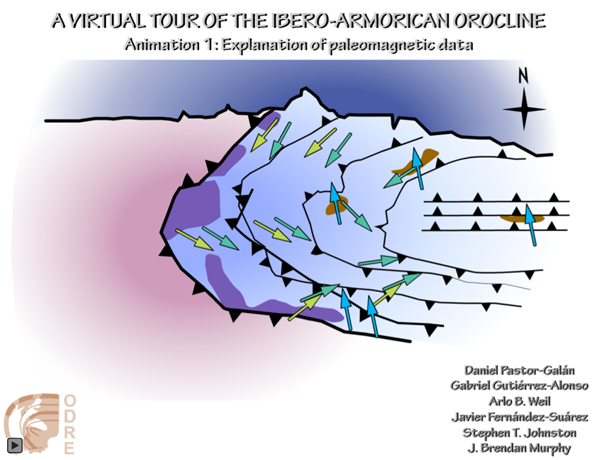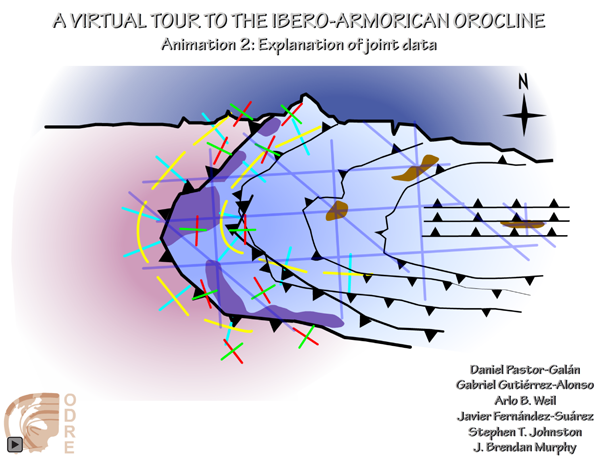Kinematics and Timing
In this section two animations are presented that summarize the two methods used to constrain the timing of orocline development: paleomagnetic data (Animation 1) and joint pattern development (Animation 2) performed in the Cantabrian Arc, within the Cantabrian Zone (CZ).
The orocline model for the Ibero-Armorican arc relies on a wealth of paleomagnetic (e.g. Parés et al., 1994; Weil et al., 2000, 2001, 2010; Weil, 2006) and structural data (e.g. Julivert and Marcos, 1973; Alonso et al., 2009; Pastor-Galán et al., 2011; 2012a). It is characterized by early longitudinal thrust and folds generated by east-west shortening (in present coordinates) subsequently folded by a north-south shortening (e.g. Julivert and Marcos, 1973; Pastor-Galán et al., 2012a). Based on paleomagnetic (van der Voo et al., 1997; Weil et al., 2000, 2001; 2010; Weil, 2006) and geological constraints (Pastor-Galán et al., 2011; Gutiérrez-Alonso et al., 2012), it is inferred that the orocline developed during a period of ~10 Ma in the uppermost Carboniferous (from 310 to 300 Ma). The orocline formation produced a N-S shortening that buckled the Variscan chain, a N-S directed thrust emplacement in the Cantabrian Arc (Merino-Tome et al., 2009) and the reactivation of major structures like the Leon Fault (Alonso et al., 2009).
Palaeomagnetic data (Animation 1) constrain the kinematics and timing of orocline formation. Rocks of the northern Gondwana foreland of the Variscan Belt in the Cantabrian Arc were remagnetized during and after early Variscan imbricate thrusting, yielding two syn-tectonic magnetizations. These magnetizations define two lineations that can be used to reconstruct the geometry of the arc at various times during its evolution (C and B magnetizations, Bashkirian and Moskovian in Animation 1; Hirt et al., 1992; Parés et al., 1994; Stewart, 1995a; Van der Voo et al., 1997; Weil et al., 2000, 2001). Unconformably overlying Early Permian continental strata along both limbs of the orocline preserve a primary magnetization that records no vertical-axis rotation, thus constraining the timing of vertical-axis rotations (eP magnetization, Permian in Animation 1; Weil et al., 2010).
Animation - Animation 1.

Interpretation of magnetic lineation acquisition prior to oroclinal buckling, and the subsequent clockwise rotation of the orocline's northern limb, and counter-clockwise rotation of its southern limb. The animation highlights the post-buckling Permian remagnetization showing no more vertical axis rotation and constraining the timing of oroclinal buckling. The constraints suggest that the orocline post-dates the acquisition of the syn-tectonic remagnetization of thrust imbricated strata at about 315 to 310 Ma, and predates deposition of the unconformably overlying Early Permian strata at about 299 Ma.
Animation 1 shows an interpretation of magnetic lineation acquisition prior to oroclinal buckling, and the subsequent clockwise rotation of the orocline’s northern limb, and counter-clockwise rotation of its southern limb. The animation highlights the post-buckling Permian remagnetization. The paleomagnetic constraints suggest that the orocline post-dates the acquisition of the syn-tectonic remagnetization of thrust imbricated strata at about 315 to 310 Ma, and predates deposition of the unconformably overlying Early Permian strata at ~299 Ma.
Joint sets (Animation 2) in the Cantabrian Arc Ibero-Armorican orocline are developed in strata that span the duration of Variscan orogenesis, including orocline formation (Pastor-Galán et al., 2011; Gutiérrez-Alonso et al., 2012). Joints in structurally imbricated strata that are continuously exposed around the orocline are related to thrust formation and oroclinal buckling (Moskovian in Animation 2; Pastor-Galán et al., 2011). Syn-orogenic strata constrain thrust fault formation to have occurred by ca. 315-310 Ma (e.g., Alonso, 1987; Keller et al., 2007; Merino-Tomé et al., 2009). Two orthogonal joint sets are identified, one parallel to, and one normal to arc-parallel thrust traces and the axes of thrust-related fault-bend folds. The joint sets systematically trace the curvature of the arc, changing orientation with regional strike around the orocline (Moskovian to Permian in Animation 2). Upper Pennsylvanian strata, deposited in continental basins, unconformably overlie the older, thrust imbricated strata (Kasimovian, 306 Ma in Animation 2). These strata have a younger orthogonal joint set that, when traced around the orocline, displaying a change in strike that defines about 60% of total arc curvature (Kasimovian to Permian in Animation 2). These sedimentary rocks are interpreted to have been deposited, and their joint sets developed, during orocline formation (Pastor-Galán al., 2011). Finally, joint sets in Early Permian strata that unconformably overlie the bent Variscan structures have joint sets that show no systematic change in orientation around the trace of the Cantabrian Arc, and are interpreted to post-date orocline formation (Permian, <299 Ma in Animation 2). Hence, these pre-, syn- and post-orocline sedimentary sequences and their joint sets indicate that the Cantabrian Arc formed after 315 Ma but prior to the Early Permian (pre- 299 Ma). This time frame is consistent with Upper Pennsylvanian strata (307 to 299 Ma) having been deposited during orocline formation.
Animation - Animation 2.

Interpretation of the formation of joint sets in the Cantabrian Arc. In pre-oroclinal buckling rocks, two orthogonal joint sets that traces the curvature of the arc are identified, one parallel to, and one normal to arc-parallel thrust traces and the axes of thrust-related fault-bend folds (Moskovian). Syn-orogenic strata constrain thrust fault formation to have occurred by ca. 315 - 310 Ma (e.g., Alonso, 1987; Keller et al., 2007; Merino-Tomé et al., 2009). Syn-orocline rocks (Upper Pennsylvanian strata, Kasimovian, 306Ma) have a younger orthogonal joint set that, when traced around the orocline, display a change in strike that defines about 60% of total arc curvature (Kasimovian to Permian). Finally, joint sets in Early Permian strata that unconformably overlie the bent Variscan structures have joint sets that show no systematic change in orientation around the trace of the Cantabrian Arc (Permian, <299Ma in Animation 2).